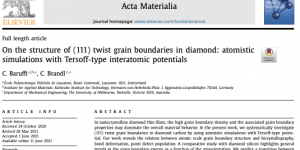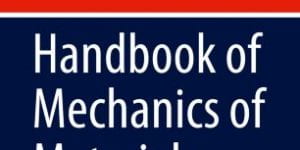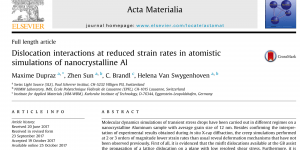cbrandl
PhD / dr. sc. École Polytechnique Fédérale de Lausanne EPFL (Switzerland) Dipl.-Ing. Karlsruhe Institute of Technology (Germany) My research focuses on predictive atomistic simulation approaches to enable rational materials design. With his expertise on defects (e.g. dislocations, interfaces) in materials, he investigates defect-dominated properties (i.e.; strength, reliability, stability) in advanced engineering materials: ranging from metallic nanomaterials (i.e. nanocrystalline metals, nanoparticle, nanolaminates, nanowires), to refractory metals/high entropy alloys.
-
Available Joint-PhD project in Jülich-University of Melbourne Postgraduate Academy
In-situ and in-silico investigations of hydrogen-induced deformation localisation Details click here Advancements in technology are enabled by materials that allow safe and efficient performance, ranging from turbines in airplanes and powerplants, to oil and gas pipelines and more lightweight transport materials that allow the reduction of carbon emissions. Engineering alloys are an enabler in our […] -
Computational alloy design for cold spray deposition
Principal Investigators: Graham Schaffer, Zhe Liu, Tesfaye Molla, Christian Brandl The aim of this project is to design a new generation of proprietary, high-performance alloys and composites that are optimised for cold spray deposition. Cold spray is a new manufacturing technology that is used to create coatings for enhancement, repair, restoration and for additive manufacturing. […] -
Twitter
blogs.unimelb.edu.au/materials-mechanics-modelling/2021/10/19/twitter
-
Available PhD topics
Scholarships are available Mechanics of nanostructured materials PhD project: The strength and reliability of engineering materials are related to the internal microstructure, which includes materials imperfections (eg, interfaces, impurities, dislocations) with their respective size and distances to each other. Nanostructured materials have extraordinary and unexpected properties compared to traditional engineering alloys due to a nanoscale […]blogs.unimelb.edu.au/materials-mechanics-modelling/2021/09/01/mechanics-of-nanostructured-materials
-
On the structure of (111) twist grain boundaries in diamond: atomistic simulations with Tersoff-type interatomic potentials
https://doi.org/10.1016/j.actamat.2021.117055 Abstract: In nanocrystalline diamond thin films, the high grain boundary density and the associated grain boundary properties may dominate the overall material behavior. In the present work, we systematically investigate (111) twist grain boundaries in diamond carbon by using atomistic simulations with Tersoff-type potential. Our work reveals the relation between atomic scale grain boundary […] -
Molecular Dynamics Simulations of Nanopolycrystals
http://link.springer.com/10.1007/978-981-10-6855-3_12-1 Abstract: Nanopolycrystals are polycrystalline metals with an average grain size below 100 nm and exhibit extraordinary strength values. In contrast to the coarse-grained polycrystals, the confinement by grain boundaries of the plastic deformation in the grains approaches limits, where the conventional theories break down. In the grain size regime 10–20 nm, molecular dynamics simulations play a […] -
Development of an ICME Paradigm for Advanced Acoustic Materials
Principal Investigators: Graham Schaffer, Tuan Ngo, Christian Brandl, Peter Daivis Researchers from DST, the University of Melbourne and RMIT University will join with industry partners QinetiQ and Matrix Composites & Engineering to research new materials designed to enhance submarine stealth. https://t.co/Y1C0iVDqVr -
Dislocation interactions at reduced strain rates in atomistic simulations of nanocrystalline Al
https://linkinghub.elsevier.com/retrieve/pii/S1359645417309023 Abstract: Molecular dynamics simulations of transient stress drops have been carried out in different regimes on a nanocrystalline Aluminum sample with average grain size of 12 nm. Besides confirming the interpretation of experimental results obtained during in situ X-ray diffraction, the creep simulations performed at 2 or 3 orders of magnitude lower strain rates […] -
Self-organized point defect arrays in diamond (SODAs)
Principle investigator: Christian Brandl Application: Quantum technology More information On the structure of (111) twist grain boundaries in diamond: atomistic simulations with Tersoff-type interatomic potentials -
Identification of the intrinsic deformation mechanisms of single-phase body-centred cubic high entropy alloys
A project in the DFG Priority Programme “Compositionally Complex Alloys – High Entropy Alloys (CCA-HEA)” (SPP 2006) Principal Investigators: Ruth Schwaiger, Christian Brandl Body-centred cubic (BCC) refractory high-entropy alloys (HEAs) have been studied as novel metallic systems for high-temperature applications due to their, for example, superior strength, excellent thermal stability, and oxidation resistance even at […]
Number of posts found: 13




